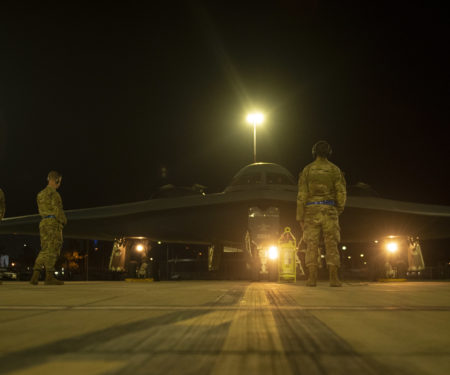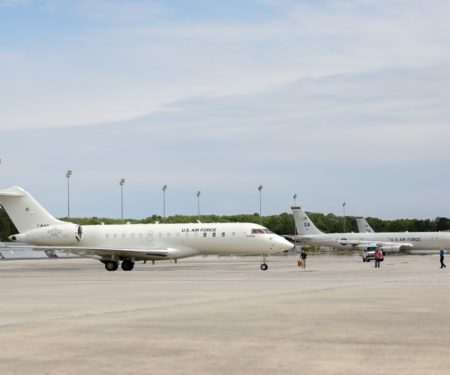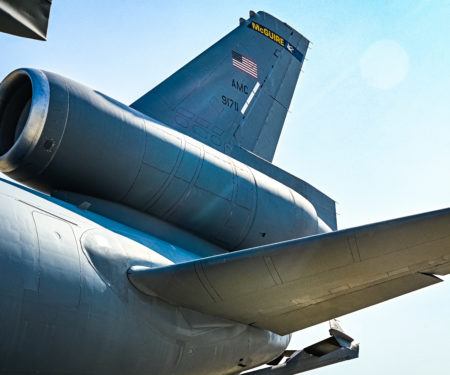Radar Sweep
T-7A Delays Compound Pilot Shortage, Expose Digital Engineering Pitfalls
Advertised by the Air Force and Boeing as the service’s first "digitally designed and engineered" aircraft, T-7A was lauded as a poster child for developmental speed. The Red Hawk was expected to begin a new era in rapid design and engineering with iterative development carried out in the virtual world via modeling and simulation without having to bend metal or conduct extensive real-world testing. Systems integration would be accelerated and the time from the first flight to production significantly compressed. It hasn’t worked out that way.
Space Development Agency Issues Draft Solicitation for 100 Satellites
The Space Development Agency is planning a new procurement of 100 satellites to continue to build out a military constellation in low Earth orbit. In a May 11 draft solicitation, the agency laid out its requirements for 100 “Alpha” satellites that will be part of a mesh network known as Transport Layer Tranche 2. The Transport Layer Tranche 2 also includes 72 “Beta” satellites for which SDA already has requested bids.
Sikorsky Spins Up to Defend HH-60W Combat Rescue Helicopter from Planned Cuts
From the time an order is received at Sikorsky’s facilities, it takes about three years for a brand-new HH-60W Jolly Green II to arrive at this point: the fully assembled helicopter has officially been accepted by the Air Force, and will soon fly away to one day embark on rescue missions around the globe. This particular helicopter is the 31st the service has taken possession of, but just how many more are slated to roll off its production line here is a source of controversy. As part of its fiscal 2024 budget request, the Air Force stuck to plans established last year to end procurement of the helicopter, dropping an original program of record from 113 to 75.
Air Force Scrambles to Address Officer Training School Instructor Shortage
The Air Force is scrambling to overcome a significant shortage in the number of instructors at its only Officer Training School at Maxwell Air Force Base in Alabama and has resorted to pulling staff members back into the field as well as combining classes. Maj. Nate Roesler, a spokesman for Air University at Maxwell Air Force Base, told Military.com that the school is “currently at 53 percent of what our production requirement demands” for instructors.
Go Deeper on Operational Imperatives
Virtually every part of the Department of the Air Force’s drive to modernize is being shaped by Secretary Frank Kendall’s seven Operational Imperatives—lines of effort that address the most important and urgent challenges facing the Air Force today. Now, the department and industry are working together to develop solutions for each imperative, and the results will likely change the Air Force and Space Force for the next generation. Keep up with all the latest news on each Operational Imperative.
PODCAST: The B-21 Imperative: America’s Deterrence Bomber
In the Aerospace Advantage podcast's episode 128, retired Maj. Gen. Larry Stutzriem and retired Col. Mark Gunzinger discuss the B-21 Raider. The U.S. military's ability to conduct long-range strikes has diminished due to capacity cuts and deferred modernization, with the current inventory of aging bombers lacking the attributes necessary to combat modern threats. The B-21 Raider, the world's most advanced stealthy bomber, will soon be fielded by the Air Force. However, ensuring the program is resourced to meet operational demands will be a continuing challenge to avoid repeating past budget-driven decisions that cut advanced combat aircraft purchases.
Air Guard Considers Cutting Enlisted Mental Health Specialists
The Air National Guard is considering cutting its corps of enlisted mental health specialists, but a final decision is still in the works, a spokesperson told Air Force Times. “Care for our Airmen and their mental health is very important to the Air National Guard,” ANG spokesperson Lt. Col. Amber Schatz said in an email. She declined to answer questions about why the Guard is considering the move and when it may happen.
Russia Appears to Lose 4 Military Aircraft in Russian Territory
Moscow appears to have lost four military aircraft in downings on May 13 in the Bryansk region of Russia, some 50 kilometers northeast of the border with Ukraine. Two Mi-8 military helicopters and two fighter jets—an Su-34 and an Su-35—suffered crashes on Saturday, according to reports by Russian state media and pro-Kremlin bloggers. All crew members of the aircraft died, according to the reports. “Two Mi-8s, one Su-34, and one Su-25 were lost. Tragedy,” Russian propagandist Andrei Rudenko reported. “They were hit near the border of the Russian Federation and most likely with air-to-air missiles,” he said. The cause of the downings could not be confirmed.
Pentagon CIO Wants to See Acceleration on JWCC
With the Pentagon’s first enterprise cloud contract underway, the Department of Defense’s top IT officer wants to move even faster to start getting capabilities to warfighters. The Joint Warfighting Cloud Capability (JWCC), which was awarded in December, is the DOD’s highly anticipated $9 billion enterprise cloud effort that replaced the maligned Joint Enterprise Defense Infrastructure (JEDI) program. Google, Oracle, Amazon Web Services, and Microsoft were all awarded under the contract and will each compete for task orders.
An Extraordinary Mission to Find an American WWII Bomber Crew at the Bottom of the Pacific
The B-24 aircraft was carrying 11 men when it was shot down nearly 80 years ago. Reaching it involved the deepest excavation ever undertaken to recover war remains.




